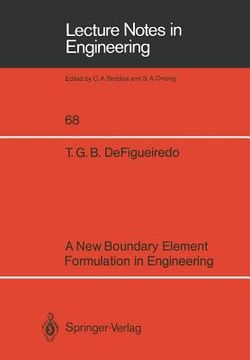Compartir
a new boundary element formulation in engineering (en Inglés)
Tania G. B. Defigueiredo
(Autor)
·
Springer
· Tapa Blanda
a new boundary element formulation in engineering (en Inglés) - Defigueiredo, Tania G. B.
$ 185.979
$ 232.473
Ahorras: $ 46.495
Elige la lista en la que quieres agregar tu producto o crea una nueva lista
✓ Producto agregado correctamente a la lista de deseos.
Ir a Mis Listas
Origen: Estados Unidos
(Costos de importación incluídos en el precio)
Se enviará desde nuestra bodega entre el
Lunes 22 de Julio y el
Miércoles 31 de Julio.
Lo recibirás en cualquier lugar de Argentina entre 1 y 3 días hábiles luego del envío.
Reseña del libro "a new boundary element formulation in engineering (en Inglés)"
1. 1 The Hybrid Displacement Boundary Element Model This work is concerned with the derivation of a numerical model for the solution of boundary-value problems in potential theory and linear elasticity. It is considered a boundary element model because the final integral equation involves some boundary integrals, whose evaluation requires a boundary discretization. Furthermore, all the unknowns are boundary vari- ables. The model is completely new; it differs from the classical boundary element formulation -in the way it is generated and consequently in the fi- nal equations. A generalized variational principle is used as a basis for its derivation, whereas the conventional boundary element formulation is based on Green's formula (potential problems) and on Somigliana's identity (elas- ticity), or alternatively through the weighted residual technique. 2 The multi-field variational principle which generates the formulation in- volves three independent variables. For potential problems, these are the potential in the domain and the potential and its normal derivative on the boundary. In the case of elasticity, these variables are displacements in the domain and displacements and tractions on the boundary. For this reason, by analogy with the assumed displacement hybrid finite element model, ini- tially proposed by Tong [1] in 1970, it can be called a hybrid displacement model. The final system of equations to be solved is similar to that found in a stiffness formulation. The stiffness matrix for this model is symmetric and can be evaluated by only performing integrations along the boundary.
- 0% (0)
- 0% (0)
- 0% (0)
- 0% (0)
- 0% (0)
Todos los libros de nuestro catálogo son Originales.
El libro está escrito en Inglés.
La encuadernación de esta edición es Tapa Blanda.
✓ Producto agregado correctamente al carro, Ir a Pagar.

